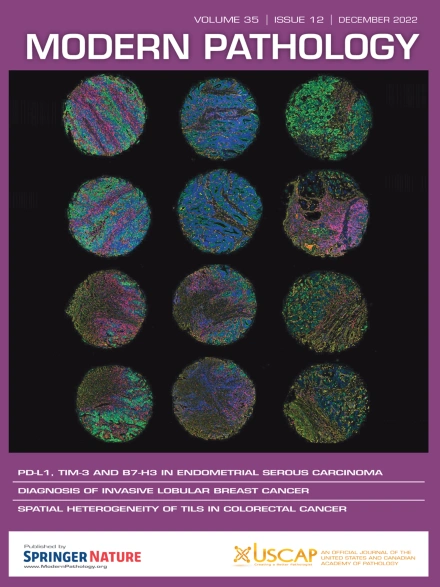Efficient and Generalizable Prediction of Molecular Alterations in Multiple-Cancer Cohorts Using Hematoxylin and Eosin Whole Slide Images
IF 7.1
1区 医学
Q1 PATHOLOGY
引用次数: 0
Abstract
Molecular testing of tumor samples for targetable biomarkers is restricted by a lack of standardization, turnaround time, cost, and tissue availability across cancer types. Additionally, targetable alterations of low prevalence may not be tested in routine workflows. Algorithms that predict DNA alterations from routinely generated hematoxylin and eosin–stained images could prioritize samples for confirmatory molecular testing. Costs and the necessity of a large number of samples containing mutations limit approaches that train individual algorithms for each alteration. In this work, models were trained for simultaneous prediction of multiple DNA alterations from hematoxylin and eosin images using a multitask approach. Compared with biomarker-specific models, this approach performed better on average, with pronounced gains for rare mutations. The models reasonably generalized to independent temporal holdout, externally stained, and multisite The Cancer Genome Atlas test sets. Additionally, whole slide image embeddings derived using multitask models demonstrated strong performance in downstream tasks that were not a part of training. Overall, this is a promising approach to develop clinically useful algorithms that provide multiple actionable predictions from a single slide.
利用H&E整张幻灯片图像对多种癌症队列的分子改变进行有效和可推广的预测。
肿瘤样本中可靶向生物标志物的分子检测受到缺乏标准化、周转时间、成本和跨癌症类型组织可用性的限制。此外,低流行率的目标改变可能无法在常规工作流程中进行测试。从常规生成的苏木精和伊红(H&E)染色图像中预测DNA变化的算法可以优先考虑样品进行确认性分子测试。成本和包含突变的大量样本的必要性限制了为每个变化训练单个算法的方法。在这项工作中,使用多任务方法训练模型同时预测H&E图像中的多个DNA改变。与生物标志物特异性模型相比,这种方法平均表现更好,对罕见突变有明显的好处。这些模型合理地推广到独立的时间保留、外部染色和多站点TCGA测试集。此外,使用多任务模型导出的整个幻灯片图像嵌入在非训练部分的下游任务中表现出很强的性能。总的来说,这是一种很有前途的方法,可以开发临床有用的算法,从一张幻灯片中提供多个可操作的预测。
本文章由计算机程序翻译,如有差异,请以英文原文为准。
求助全文
约1分钟内获得全文
求助全文
来源期刊

Modern Pathology
医学-病理学
CiteScore
14.30
自引率
2.70%
发文量
174
审稿时长
18 days
期刊介绍:
Modern Pathology, an international journal under the ownership of The United States & Canadian Academy of Pathology (USCAP), serves as an authoritative platform for publishing top-tier clinical and translational research studies in pathology.
Original manuscripts are the primary focus of Modern Pathology, complemented by impactful editorials, reviews, and practice guidelines covering all facets of precision diagnostics in human pathology. The journal's scope includes advancements in molecular diagnostics and genomic classifications of diseases, breakthroughs in immune-oncology, computational science, applied bioinformatics, and digital pathology.
 求助内容:
求助内容: 应助结果提醒方式:
应助结果提醒方式:


